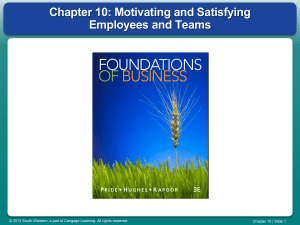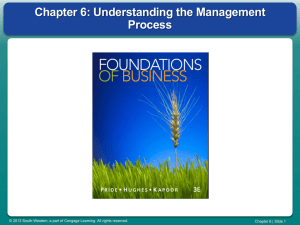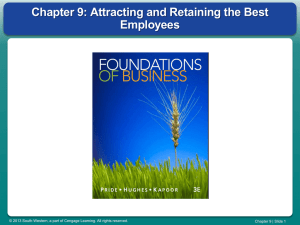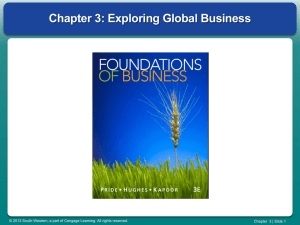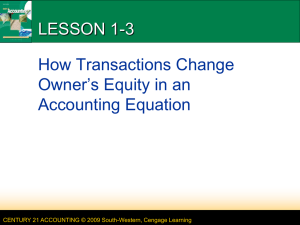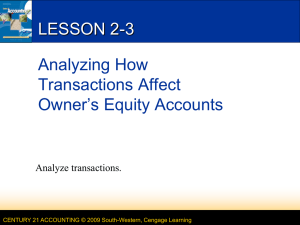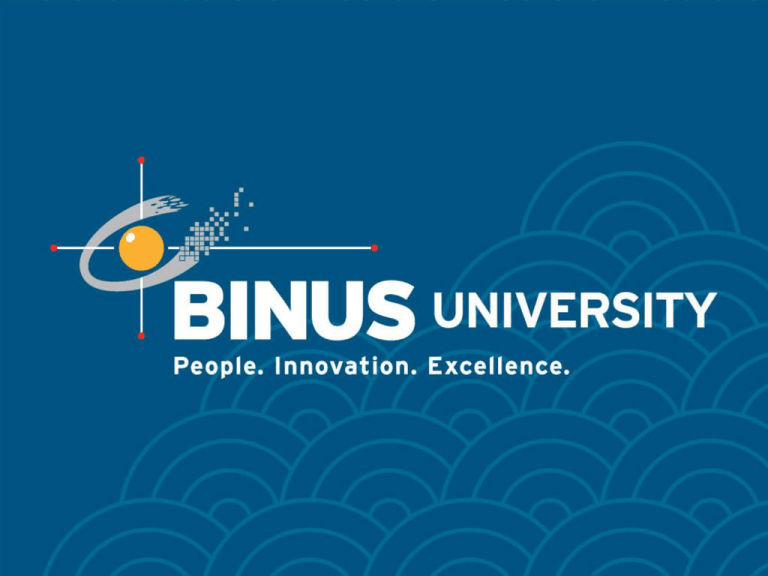
Matakuliah
Tahun
: J0124-Manajemen Sumber Daya Manusia
: 2010
The Challenge of
Human Resource Management
1
12
PowerPoint Presentation by Charlie Cook
The University of West Alabama
Learning Outcomes
After studying this chapter, the students should be able to :
• Identify how firms gain a sustainable competitive
advantage through people
• Explain how globalization is influencing HRM
Bina Nusantara University
4
Why Study Human Resources Management
• Human Resources Management (HRM)
The process of managing human resources (human
capital and intellectual assets) to achieve an
organization’s objectives.
• “Why Study HRM?”
Staffing the organization, designing jobs and teams,
developing skillful employees, identifying
approaches for improving their performance, and
rewarding employee successes—all typically labeled
HRM issues—are as relevant to line managers as they
are to managers in the HR department.
© 2010 South-Western, a part of Cengage Learning. All rights reserved
FIGURE
1.1
Overall Framework for Human Resources Management
© 2010 South-Western, a part of Cengage Learning. All rights reserved.
Competitive Challenges and
Human Resources Management
• The most pressing competitive issues facing
firms:
Competing, recruiting, and staffing globally
Embracing new technology
Managing change
Managing talent, or human capital
Responding to the market
Containing costs
© 2010 South-Western, a part of Cengage Learning. All rights reserved.
Challenge 1: Competing, Recruiting, and
Staffing Globally
• Globalization
The trend toward opening up foreign markets to
international trade and investment
• Impact of Globalization
“Anything, anytime, anywhere” markets
Partnerships with foreign firms
Lower trade and tariff barriers
NAFTA, EU, APEC trade agreements
WTO and GATT
© 2010 South-Western, a part of Cengage Learning. All rights reserved.
Challenge 1…(cont’d)
• Corporate Social Responsibility (CSR)
The responsibility of the firm to act in the best
interests of the people and communities affected by
its activities
• Globalization’s Impact on HRM
Different geographies, cultures, laws, and business
practices
Issues:
Identifying capable managers and workers
Developing foreign culture and work practice training
programs.
Adjusting compensation plans for overseas work
© 2010 South-Western, a part of Cengage Learning. All rights reserved.
Challenge 2: Embracing New Technology
• Knowledge Workers
Workers whose responsibilities extend beyond the
physical execution of work to include planning,
decision making, and problem solving.
• Knowledge-Based Training
Online instruction
“Just-in-time” learning via the Internet
on company intranets
Virtual learning
© 2010 South-Western, a part of Cengage Learning. All rights reserved
Influence of Technology in HRM
• Human Resources Information System (HRIS)
A computerized system that provides current and
accurate data for the purposes of control and
decision making.
Benefits:
Automation of routine tasks, lower administrative costs,
increased productivity and response times.
Self-service access to information and training for managers
and employees
Online recruiting, screening, and pretesting of applicants
Training, tracking, and selecting employees based on their
record of skills and abilities
Organization-wide alignment of “cascading” goals
© 2010 South-Western, a part of Cengage Learning. All rights reserved
2
Automation of Talent Management Functions
© 2010 South-Western, a part of Cengage Learning. All rights reserved
HRM IT Investment Factors
• Fit of the application to
the firm’s employee
base.
• Ability to upgrade
Increased efficiency and
time savings
• Compatibility with
• Time required to
implement and train staff
members to use HRIS
• Initial and annual
maintenance costs
• Training time required for
HR and payroll
current systems
• Availability of technical
support
© 2010 South-Western, a part of Cengage Learning. All rights reserved
Challenge 3: Managing Change
• Types of Change
Reactive change
Change that occurs after external forces have already
affected performance
Proactive change
Change initiated to take advantage of targeted opportunities
• Managing Change through HR
Formal change management programs help to keep
employees focused on the success of the business.
© 2010 South-Western, a part of Cengage Learning. All rights reserved
Challenge 3: Managing Change (cont’d)
• Why Change Efforts Fail:
Not establishing a sense of urgency.
Not creating a powerful coalition to guide the
effort.
Lacking leaders who have a vision.
Lacking leaders who communicate the vision.
Not removing obstacles to the new vision.
Not systematically planning for and creating short-
term “wins.”
Declaring victory too soon.
Not anchoring changes in the corporate culture.
© 2010 South-Western, a part of Cengage Learning. All rights reserved
Challenge 4: Managing Talent, or Human Capital
• Human Capital
The knowledge, skills, and capabilities of
individuals that have economic value to an
organization.
Valuable because capital:
is based on company-specific skills.
is gained through long-term experience.
can be expanded through development.
© 2010 South-Western, a part of Cengage Learning. All rights reserved
Challenge 5: Responding to the Market
• Total Quality Management (TQM)
A set of principles and practices whose core ideas
include understanding customer needs, doing things
right the first time, and striving for continuous
improvement.
• Six Sigma
A process used to translate customer needs into a
set of optimal tasks that are performed in concert
with one another.
HR facilitates organizational development of Six Sigma.
HR helps balance the opposing needs for order and control
with the needs for growth and creativity.
© 2010 South-Western, a part of Cengage Learning. All rights reserved
Challenge 5: Responding to the Market (cont’d)
• Reengineering and HRM
Fundamental rethinking and radical redesign of
business processes to achieve dramatic
improvements in cost, quality, service, and speed.
Requires that managers create an environment for change.
Depends on effective leadership and communication
processes.
Requires that administrative systems be reviewed and
modified.
© 2010 South-Western, a part of Cengage Learning. All rights reserved
Challenge 6: Containing Costs
• Downsizing
The planned elimination of jobs (“head count”).
Layoffs
• Outsourcing
Contracting outside the organization to have work
done that formerly was done by internal employees.
• Offshoring (Global Sourcing)
The business practice of sending jobs to other
countries.
© 2010 South-Western, a part of Cengage Learning. All rights reserved
Challenge 6: Containing Costs (cont’d)
• Hidden Costs of a Layoff
Severance and rehiring costs
Accrued vacation and sick day payouts
Pension and benefit payoffs
Potential lawsuits from aggrieved workers
Loss of institutional memory and trust in
management
Lack of staffers when the economy rebounds
Survivors who are risk-averse, paranoid, and
political
© 2010 South-Western, a part of Cengage Learning. All rights reserved
Challenge 6: Containing Costs (cont’d)
• Benefits of a No-Layoff Policy
A fiercely loyal,more productive workforce
Higher customer satisfaction
Readiness to snap back with the economy
A recruiting edge
Workers who aren’t afraid to innovate, knowing
their jobs are safe.
© 2010 South-Western, a part of Cengage Learning. All rights reserved
FIGURE
1.2
Estimated Number and Types of U.S. Jobs Estimated to
Move Offshore between 2010 and 2015
© 2010 South-Western, a part of Cengage Learning. All rights reserved
Challenge 6: Containing Costs (cont’d)
• Employee Leasing
The process of dismissing employees who are then
hired by a leasing company (which handles all HRrelated activities) and contracting with that
company to lease back the employees.
© 2010 South-Western, a part of Cengage Learning. All rights reserved
FIGURE
1.3
Productivity Enhancements
© 2010 South-Western, a part of Cengage Learning. All rights reserved
Demographic and Employee Concerns
• Demographic Changes
More diverse workforce
Ethnic and cultural challenges
Aging workforce
More educated workforce
Necessity of basic skills training
• Managing Diversity
Being aware of characteristics
common to employees, while
also managing employees as
individuals
© 2010 South-Western, a part of Cengage Learning. All rights reserved
3
Social Issues in HRM
Changing Demographics: The coming decades will bring a more diverse and aging workforce to
developed countries such as the United States. This has major implications for all aspects of HRM
because it alters traditional experience and expectations regarding the labor pool. Among the
issues in this area are:
• Globalization
• Diversity strategies
• Shrinking pool of skilled entry-level workers • Social Security and retirement issues
• Rising health care costs for employees
• Continual skills development and retraining
• Outsourcing, offshoring, and the use of temporary and part-time employees
Employer/Employee Rights: This area reflects the shift toward organizations and individuals
attempting to define rights, obligations, and responsibilities. Among the issues here are:
• Relationship employment versus transactional-based employment
• Concern for the privacy of employees
• Whistle-blowing
• Employer-employee ethics
• Legal compliance
• Comparable worth
• Mandated benefits
Attitudes toward Work and Family: Because of the increase of working women as well as
employee mobility and a growing concern about family issues, there is demand for recognizing
and supporting family-related concerns. Among the issues are:
• Day care and elder care
• Alternative work schedules
• Parental leave
• Job sharing
© 2010 South-Western, a part of Cengage Learning. All rights reserved
• Flextime
• Job rotation
• Telecommuting
FIGURE
1.4
Composition of U.S. Population
© 2010 South-Western, a part of Cengage Learning. All rights reserved
FIGURE
1.5
Labor Force and Gender Distributions
© 2010 South-Western, a part of Cengage Learning. All rights reserved
FIGURE
1.6
Education Pays
© 2010 South-Western, a part of Cengage Learning. All rights reserved
FIGURE
1.7
Model of Diversity Management Strategy
© 2010 South-Western, a part of Cengage Learning. All rights reserved
4
Why Diversity?
The primary business reasons for diversity management include . . .
© 2010 South-Western, a part of Cengage Learning. All rights reserved
Impact of Cultural Changes
Employee
Rights
Concern for
Privacy
Jobs and
Organizations
Balancing Work
and Family
© 2010 South-Western, a part of Cengage Learning. All rights reserved
Attitudes
towards Work
Qualities of HR Managers
• Responsibilities
1. Advice and counsel
2. Service
3. Policy formulation
and implementation
4. Employee advocacy
• Competencies
1. Business mastery
2. HR mastery
3. Change mastery
4. Personal credibility
© 2010 South-Western, a part of Cengage Learning. All rights reserved
FIGURE
1.8
Human Resource Competency Model
© 2010 South-Western, a part of Cengage Learning. All rights reserved

